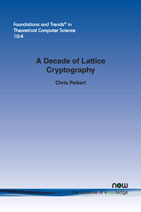A Decade of Lattice Cryptography
By Chris Peikert, University of Michigan, USA, cpeikert@gmail.com
Abstract
Lattice-based cryptography is the use of conjectured hard problems on point lattices in Rn as the foundation for secure cryptographic systems. Attractive features of lattice cryptography include apparent resistance to quantum attacks (in contrast with most number-theoretic cryptography), high asymptotic efficiency and parallelism, security under worst-case intractability assumptions, and solutions to long-standing open problems in cryptography. This work surveys most of the major developments in lattice cryptography over the past ten years. The main focus is on the foundational short integer solution (SIS) and learning with errors (LWE) problems (and their more efficient ring-based variants), their provable hardness assuming the worst-case intractability of standard lattice problems, and their many cryptographic applications.
A Decade of Lattice Cryptography
Lattice-based cryptography is the use of conjectured hard problems on point lattices in Rn as the foundation for secure cryptographic systems. Attractive features of lattice cryptography include apparent resistance to quantum attacks (in contrast with most number-theoretic cryptography), high asymptotic efficiency and parallelism, security under worst-case intractability assumptions, and solutions to long-standing open problems in cryptography.
This monograph surveys most of the major developments in lattice cryptography over the past ten years. The main focus is on the foundational short integer solution (SIS) and learning with errors (LWE) problems (and their more efficient ring-based variants), their provable hardness assuming the worst-case intractability of standard lattice problems, and their many cryptographic applications.
